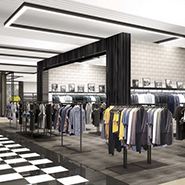- About
- Subscribe Now
- New York,
June 19, 2015

 Men's section of Bloomingdale's in Palo Alto
Men's section of Bloomingdale's in Palo Alto
Within the luxury industry, fashion brands are seeing the gap between in-store and online sales close at the sharpest rate, according to a new report by the Luxury Institute.
Convenience, better prices and wider product selection are driving consumers away from stores to ecommerce marketplaces. However, this ongoing shift away from physical locations should not spur brands to go on a store-shuttering spree, since improvements in cross-channel connectivity will put brakes on this shift, potentially reversing it.
"One reason for this migration is that fashion has been on the leading edge of online experience," said Milton Pedraza, CEO and founder of The Luxury Institute, New York.
"The second thing is that, unfortunately, clients in fashion are so much more educated than the sales people," he said. "They educate themselves, become experts in the brand and the products, so they don't see great value in going to the store.
"Another reason is because of convenience. Lets face it, it has become so easy and convenient not to go to the store."
A nationwide survey of 1,601 affluent U.S. consumers between ages 21 or older with minimum household incomes of $150,000 was conducted during quarter two 2015 for this report.
Changing habits
In-store sales still dwarf ecommerce. Consumers feel more comfortable buying a product in-person, especially when spending large sums of money.
However, the benefits of ecommerce are increasingly attractive, motivating consumers to shift more of their overall spend to digital.
Michael Kors ecommerce page
Sixty-eight percent of spend by men surveyed and 64 percent of spend by women still takes place in stores, according to the report.
In the fashion space, 23 percent of men surveyed and 26 percent of women are cutting back on in-store purchases from the year-ago period, while 52 percent of men and 46 percent of women report spending more online.
The beauty market is facing similar disruption, and jewelry and watches are finally seeing an uptick in online sales after a long period of in-store hegemony.
Sixty-seven percent of men and 45 percent of women are buying more jewelry online, and 58 percent of men and 46 percent of women are increasingly turning to ecommerce for watches.
Chaumet marriage app
Predictably, shopping patterns can be split up by age. Younger women are the most likely to shop digitally, with 41 percent of their purchases taking place online.
Meanwhile, men aged 65 and older have the highest share of in-store spend at 71 percent.
Mr. Pedraza emphasized that consumers are making a greater share of their purchases online because the in-store experience is inadequate: technology has not been effectively incorporated, design layouts are often dull and salespeople do not elevate the experience.
Plus, discount stores have altered consumer behavior by acting as warehouses of discounts in which consumers get a product as fast as they can and then leave. When consumers become accustomed to this process, ecommerce simply makes more sense.
New era
Digital pervades every part of the purchase journey, amplifying rather than hampering sales.
More than 70 percent of consumers expect brand digital channels to have knowledge of in-store product availability, according to a report by L2.
Accommodating both digital and in-store trends requires brands to adapt to ecommerce expectations of click-and-collect or free shipping, but also adhere to in-store demands. Many traditional brands face pressure from online retailers to offer better options for consumers turning to digital for both browsing and shopping (see story).
Further, the convergence of digital and physical retailing, rather than a zero-sum game between channels, is shaping up to be the future, according to a report by TimeTrade.
Consumers still appreciate being able to examine products in-person, try stuff on to check if it fits, make informed choices, enjoy the atmosphere of a store and sometimes ask sales associates questions. Although digital has made consumers more concise in their shopping habits, due to extensive research behind-the-scenes, it has not dented in-store dominance (see story).
"There are a lot of challenges in optimizing all the store elements into something that's relevant to the very informed and discerning luxury consumer," Mr. Pedraza said.
Final Take
Joe McCarthy, staff reporter on Luxury Daily, New York
Share your thoughts. Click here